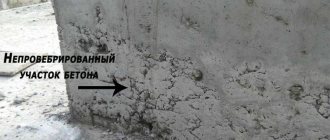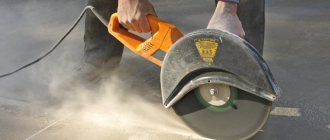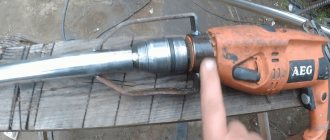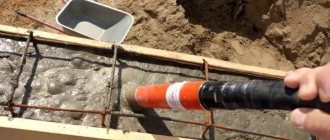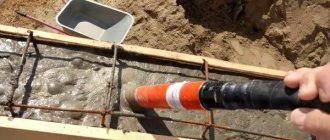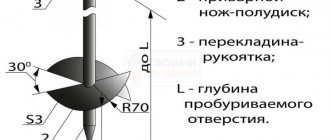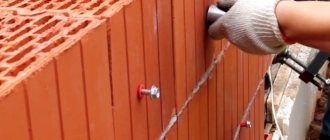Those who have their own dachas or private houses know how important concrete mortar is for any construction work, and it is especially important to know how to calculate the proportions of concrete in buckets. This is the basis of everything. Many people order mortar from construction organizations, and then struggle with the question of “when will it be delivered?” and “what quality will the mixture be?” Luckily, we'll tell you how to make high-quality concrete for your foundation yourself!
For small areas, it is better to measure the volume of components manually in buckets. By acting this way, you will spend less time on the process itself, and the solution will be of higher quality. How many buckets of components are needed to make concrete is calculated depending on the amount of work. All components for concrete composition have different amounts of capacity per bucket:
- cement 15 kg;
- sand 19 kg;
- crushed stone 17.5 kg.
Prepare a deep trough of mortar and use shovels to mix by hand.
RECOMMENDED ON THE TOPIC
- Proportions of concrete for the blind area...
- The ratio of cement and sand in...
“How much sand do you need for a bucket of cement?” - the most asked question of all beginners. Now let's look at everything in order.
The concrete recipe is used in almost all areas of construction: on foundations, wall ceilings, and when cladding both internal and external surfaces of buildings.
It is advisable to make concrete mortar using buckets in the following cases:
- No large-scale construction work is planned.
- Filling the desired area is done in stages.
- It is impossible to transport special equipment to the work site.
- A large distance from objects that can provide ready-mixed concrete.
Proportions of components per 1m3 of concrete, using buckets:
- 2 buckets of cement;
- 5 buckets of sand;
- 9 buckets of crushed stone.
Having prepared the necessary components, we begin mixing the concrete. The ratio of water and cement is 1 to 2, that is, water will require 50 percent of the amount of cement. It is better to pour it at the end, after adding all the ingredients.
It is recommended to produce the solution before starting work and in the amount that you plan to use within 2 hours.
Number of components for preparing a cubic meter of concrete
So, the following amount of materials will be required. If you use M400 cement, then for 1m3 of concrete you need:
- 338 kg cement
- 642 kg sand
- 1250 kg crushed stone
- 170 l water
If the cement is grade M500, then you will need:
- 292 kg cement
- 702 kg sand
- 1258 kg crushed stone
- 146 liters of water
As you can see, cement, sand and crushed stone are given in kilograms. But we need liters, so we will need to convert mass to volume. The values will be approximate, since bulk materials have a variable density. But even in this form they will suit us. The bulk density of cement is approximately 1200 kg/m3, sand - 1440 kg/m3, crushed stone - 1600 kg/m3.
After translation, the following values were obtained.
When using M400 cement you need:
- 281 liters of cement
- 445 l sand
- 781 l crushed stone
When using cement M500 it is necessary:
- 243 liters of cement
- 487 l sand
- 786 l crushed stone
Components
Any concrete, regardless of its brand, consists of the following components:
All these components must have the necessary characteristics, taking into account which they must be selected. Cement is the main ingredient in a concrete mixture because it is a binder. It is produced by cement factories. Cement is divided by grade and by the number of various additives it contains. The most popular Portland cement, it contains many special additives to improve the properties of the material. When pouring the foundation of a house, experts recommend that private developers use cement M 400 or PC 400.
Sand is one of the aggregates in concrete mixtures. To obtain a high-quality solution, you need to take its choice seriously. It is worth noting that at the moment the choice of sand on the construction market is huge. If you wish, you can even purchase sand from the seabed, but not every sand material is suitable for concrete.
Thus, experts do not recommend using sand with clay admixtures for this purpose. Because of this, concrete is less durable and frost-resistant. But with river sand you can prepare a solution that is ideal in condition. It is often of very high quality and consists of homogeneous fractions.
Crushed stone and gravel, as well as sand in the solution, act as fillers. Thanks to them, the solution “shrinks” less, which makes the concrete structure stronger and more durable
When choosing crushed stone, you should pay attention to its shape. Since the convenience of pouring concrete mortar depends on it
Water. This component can have any characteristics, the main thing is that the water is clean without any impurities. Having all the above components and knowing the proportions of concrete for the foundation, you can prepare a solution of any required brand.
Types of concrete foundations
The most basic types of concrete foundations are columnar and strip, but there are other subtypes and varieties:
- Tape. It is installed in the form of a continuous strip, which consists of reinforced concrete laid under all load-bearing walls of the structure. The depth of the building’s foundation is determined depending on the level of soil freezing plus an additional 20 cm. Based on indicators of soil quality and climatic zone, two subtypes can be used:
- intermittent;
continuous.
The material used for this type of base is:
- Booth, which has excellent strength. The material is not affected by low temperatures and flowing groundwater. Ruba stone of the same fraction is used. The construction process requires a lot of labor and money, so it is used very rarely. The laying depth does not exceed 70 cm, and its durability is about 150 years.
- Rubble concrete, which includes a combination of cement mortar and filler (crushed stone, small rubble stone, brick fragments) . In terms of strength, it has qualities no worse than rubble, but it is much easier to construct and more affordable. It is used to build structures made of heavy materials or consisting of several floors.
- Concrete. This type of house foundation is better known as poured, since the material is mixed in a concrete mixer, after which it is filled with formwork. The service life of the material is over 50 years, and its cost is much higher due to the large volumes of cement used. Most often, this option is used in construction for the construction of walls from non-light materials, as well as the construction of country cottages and houses.
The correct selection of material and type of foundation allows you to make the structure stronger and more durable. It is possible to buy material for the foundation in a ready-made version, in the form of mixtures at industrial enterprises. But it is much better to make the concrete solution yourself, which allows you to significantly save money.
How to calculate the composition of concrete
In order to correctly calculate the composition of concrete, it is important to have certain data. This includes:
This includes:
- Required grade of concrete;
- Required plasticity of the mixture;
- Brand of cement;
- Data on the granulometric composition of sand and crushed stone.
There are two ways to calculate the composition of concrete - by the weight ratio of cement, sand and crushed stone and the volumetric ratio of these materials. In both the first and second cases, cement is always taken as a unit (one part), and all other components of the concrete mixture are taken as part of the weight or volume of cement.
Calculation of concrete composition by weight
Let us calculate the composition to obtain concrete of medium plasticity, the strength grade of which at 28 days will be M200.
Let's assume we have:
- Portland cement M400;
- Crushed stone of medium fraction;
First, we need to determine the water-cement ratio (W/C). W/C is the proportion of the weight of water and cement that is necessary to prepare concrete of a certain strength. This indicator is determined using formulas or empirically. We offer the already found W/C values, which we have collected in the form of a table.
Table No. 2. W/C values for various grades of concrete.
| Cement brands | Concrete grades | |||||
| 100 | 150 | 200 | 250 | 300 | 400 | |
| 300 | 0,75 | 0,65 | 0,55 | 0,50 | 0,40 | – |
| 0,80 | 0.70 | 0.60 | 0.55 | 0.45 | – | |
| 400 | 0,85 | 0,75 | 0,63 | 0,56 | 0,50 | 0,40 |
| 0,90 | 0,80 | 0,68 | 0,61 | 0,55 | 0,45 | |
| 500 | – | 0,85 | 0,71 | 0,64 | 0,60 | 0,46 |
| – | 0,90 | 0,76 | 0,69 | 0,65 | 0,51 | |
| 600 | – | 0,95 | 0,75 | 0,68 | 0,63 | 0,50 |
| – | 1 | 0,80 | 0,73 | 0,68 | 0,55 | |
| – indicators for gravel. – indicators for crushed stone. |
Knowing the required grade of concrete and the grade of cement used, we find the W/C value. In this case it will be 0.63.
Now from table No. 1 we find the amount of water required to obtain concrete of medium plasticity, with a crushed stone size of 40 mm. As a result, we get a value of 190 l/m3.
After this, we can calculate the amount of cement we need per 1m3 of concrete. To do this, divide 190 l/m3 by 0.68 and get 279 kg. cement. From table No. 3 we find the proportions of the concrete mixture for the required grade of concrete M200 and grade of cement M400.
Table No. 3. Weight ratios of cement, sand and crushed stone.
| Concrete grade | Portland cement brands | |
| 400 | 500 | |
| Proportions by weight, Cement : Sand : Crushed stone | ||
| 100 | 1 : 4,6 : 7,0 | 1 : 5,8 : 8,1 |
| 150 | 1 : 3,5 : 5,7 | 1 : 4,5 : 6,6 |
| 200 | 1 : 2,8 : 4,8 | 1 : 3,5 : 5,6 |
| 250 | 1 : 2,1 : 3,9 | 1 : 2,6 : 4,5 |
| 300 | 1 : 1,9 : 3,7 | 1 : 2,4 : 4,3 |
| 400 | 1 : 1,2 : 2,7 | 1 : 1,6 : 3,2 |
| 450 | 1 : 1,1 : 2,5 | 1 : 1,4 : 2,9 |
The ratio C:P:SH will be 1: 2.8: 4.8. If we need 279 kg of cement, then 279 × 2.8 = 781 kg. sand and 279 × 4.8 = 1339 kg. crushed stone In total, it turns out that to prepare 1 m3 of concrete of medium plasticity and grade M200 from Portland cement M400 and crushed stone of the middle fraction, it is necessary:
279 kg. cement.
781 kg. sand.
1339 kg. crushed stone
190 l. water.
At home, a 10 liter bucket is often used to measure various bulk materials. To make it easier for you to measure materials, we will provide data on the mass of a particular material contained in one 10 liter bucket:
- Cement – 13 – 15 kg, depending on compaction.
- Sand – 14 – 17 kg, depending on humidity.
- Crushed stone or gravel – 15 – 17 kg, depending on the size of the fraction.
It is necessary to understand that the method of this calculation is slightly inferior to the methods used in the construction of large objects, but this is much better than the principle - give more cement to make it stronger.
In addition to using proportions by mass, proportions of concrete composition by volume are also used. However, this method is less accurate.
Table No. 4. Volume ratios of cement, sand and crushed stone for concrete of different grades:
| Brand of Portland cement | Concrete grade | Proportions by volume, l | Concrete volume, l, at a consumption of 10 l. cement | ||
| Cement | Sand | Rubble | |||
| 400 | 100 | 1 | 4,1 | 6,1 | 78 |
| 150 | 1 | 3,2 | 5,0 | 64 | |
| 200 | 1 | 2,5 | 4,2 | 54 | |
| 250 | 1 | 1,9 | 3,4 | 43 | |
| 300 | 1 | 1,7 | 3,2 | 41 | |
| 400 | 1 | 1,1 | 2,4 | 31 | |
| 450 | 1 | 1,0 | 2,2 | 29 | |
| 500 | 100 | 1 | 5,3 | 7,1 | 90 |
| 150 | 1 | 4,0 | 5,8 | 73 | |
| 200 | 1 | 3,2 | 4,9 | 62 | |
| 250 | 1 | 2,4 | 3,9 | 50 | |
| 300 | 1 | 2,2 | 3,7 | 47 | |
| 400 | 1 | 1,4 | 2,8 | 36 | |
| 450 | 1 | 1,2 | 2,5 | 32 | |
| The amount of water is not specified and depends on the required consistency and plasticity of the concrete. |
Proportions in buckets - recipe and work steps
To calculate the cost of the foundation or finishing, the mass proportion of the components is used. The standard ratio of the mass of cement, sand and crushed stone for concrete with low strength (M200) is 1:3:5, respectively, and for material with medium strength (M350) - 1:1.6:2.7.
However, directly during construction it is more convenient to use volumetric ratios. A universal measure for components is a 10 liter bucket.
The ratio of fillers, cement and water depends on the required strength of the concrete mixture. Modern construction documentation indicates not the brand, but the class of concrete (for example, B25). It correlates with the strength indicator as follows:
- M100 corresponds to B7.5;
- M150 - B12.5;
- M200 - B15;
- M250 - B20;
- M300 - B22.5;
- M350 - B25;
- M400 - B30;
- M450 - B35.
Used proportions of concrete in buckets for a concrete mixer
| Concrete class | Amount of cement, in buckets | Amount of crushed stone, in buckets | Amount of sand, in buckets |
| B12.5 | 10 | 50 | 32 |
| B15 | 42 | 25 | |
| IN 20 | 34 | 19 | |
| B22.5 | 32 | 17 | |
| B25 | 24 | 14 | |
| B30 | 24 | 11 | |
| B35 | 22 | 10 |
This proportion is given for medium-strength cement grades. When using high-strength binding material, its quantity in ratio is reduced. The ratio of the components is based on their bulk density: for cement it is 15 kg/bucket, for crushed stone - 17.5 kg/bucket, for sand - 19 kg/bucket.
The volume of water for preparing the mixture should be 0.6-1.15 volumes of cement. The amount of water depends inversely on the strength of the brand.
How to properly mix concrete in a concrete mixer:
- Calculate the required number of components and prepare cement, fillers and water with a reserve. To ensure the strength of the material, the sand is pre-screened, and the crushed stone is washed and dried. You need to dry the filler on a tarpaulin or other covering, because... otherwise it may become contaminated with clay.
- Place the concrete mixer on a flat surface or a specially formed platform. Lubricate the walls of the device with a mixture of water, cement and sand to reduce the adhesion of concrete. If it is not possible to process the mixer, then the proportion of sand and cement for the first batch of concrete should be increased (10% is enough).
- Turn on the concrete mixer and start loading fillers. For large devices, it is recommended to fill with water and add about half of the dry ingredients. Then the remainder of the cement, crushed stone and sand is gradually poured into the hole of the device. Wait about a minute between additions. For small concrete mixers, a different sequence may be recommended: sand, cement and a small part of gravel are first loaded, the mass is thoroughly mixed and diluted with water. After repeated mixing, the rest of the crushed stone is filled in.
- Plasticizers and other modifying additives are added after other ingredients. At home, liquid soap or dish soap (2 tbsp) will help increase the plasticity of concrete. If water is added after the dry ingredients, the plasticizer can be pre-dissolved in it.
- When using a concrete mixer with forced mixing, the residence time of concrete in the device should not be more than 1-2 minutes. If a gravity-type mixer is used, the mixing time will be 1-2.5 minutes. Mixing time is calculated for the final mixture with a full load of components.
- To check the readiness of the concrete, you need to slightly tilt the mixer container, pour a little solution and make 4-5 notches on it with a shovel. A quality mixture remains smooth but retains peaks between the cuts. If the formed ridges fall off, then the poured solution must be loaded back into the tank. The readiness of concrete is also determined by its consistency. The most optimal is a dense curdled solution, which remains plastic enough for molding.
- The finished mixture is unloaded into prepared buckets or a wheelbarrow. You need to use it as quickly as possible. If the solution has hardened, it cannot be diluted with water or stirred by hand: this sharply reduces the strength characteristics.
- After use, you need to wash the walls of the concrete mixer. To do this, you need to take 5-7 liters of clean water and some sand. The drained water with fine aggregate can be used to prepare the next batch of concrete.
Some builders make a test batch of material before the main mixing. This avoids both concrete cracking due to high humidity and excessive compaction, which makes working with the mortar difficult.
The difference in proportions may be due to the fractions of sand and crushed stone, the brand of cement, the “heap” set, the characteristics of the concrete mixer, etc.
Main process
Concrete produced in a concrete mixer has higher quality indicators compared to mortar mixed with your own hands. In addition, the labor intensity and duration of the process are reduced.
A solution is prepared in a concrete mixer using the following technology:
- The component composition is selected and the proportions of materials are calculated.
- Prepare the fillers. If necessary, they are sifted, washed, and dried. Water, if necessary, is settled.
- Gradually, taking into account the density, load the components into the mixer and add water.
- Add excipients.
- After loading the inert materials, they begin to knead them.
- Check the readiness of the mixture. To do this, make several notches with a shovel on the surface of the solution. The finished mixture has a smooth surface with preservation of peaks between the notches. The consistency of the finished solution is cheesy, but quite plastic.
- Unload the mixture. It is convenient to use a metal bath or trough.
- Clean the concrete mixer and equipment.
Before filling in a new batch of solution components, remove the remnants of the finished mixture. To do this, clean water (5-7 l) is poured into the drum, to which sand is added. After draining, it can be used to knead the next batch of mixture.
What is concrete
The physical properties of concrete are determined by what it is made of and how it was made
In order to better understand it, you need to pay attention to its components
Cement
This element can be considered the main one in the concrete preparation process. The legislation stipulates that its quality must comply with TP-166-04, GOST 31108-2003 and SNiP 2.03.11-85.
In order to ensure that the cement is of high quality, it must meet certain conditions. Here are some of them:
- The grinding fineness should reach 350-380 square meters. meters per kilogram. It may differ from the specified norm, but no more than 10%.
- After 2-3 hours the solution should show the first signs that it is setting. The process should complete after 4-5 hours have passed.
The density of the cement mixture should be such that the water content in it does not exceed 25-27%.
Concrete can be used to make interior decoration.
Using Placeholders
In this capacity, sand, gravel or their combinations are used, which perform the following functions:
- Thanks to additives, concrete becomes much more durable.
- Aggregates make it cheaper to use concrete - after all, sand and stones are cheaper than cement.
It is important to note that construction sand is different from regular sand. The difference lies in the shape of most of its grains of sand - in construction sand they have a rounded shape and approximately equal size
In addition, it contains a little clay, which increases its plasticity.
Granite chips, gravel or crushed stone are most often used as large-sized aggregate. The first option is used for the production of the most durable grades of concrete (for example, M 500). For M 350 and weaker, gravel and crushed stone are used.
Water
This component can be called the second most important. Clean water is used
However, its required quantity is determined taking into account water absorption by cement and depending on the presence and composition of special additives.
The appropriate amount of water will allow you to obtain a solution of the desired consistency.
Application of additives
The use of additional substances in the production of concrete serves the following purposes:
- Giving concrete certain desired properties.
- Acceleration of hardening of the cement mixture.
The need to use additives and plasticizers is determined by the specific use of concrete.
Kinds
There are three types of concrete foundations:
- Tape.
- Slab.
- Columnar.
It should be noted that each is selected depending on the specific conditions of use. To make it clear when to use each type, you need to point out the functions they provide.
Tape
Strip foundation” width=”300″ height=”216″ />
This type of foundation is used for heavy-walled buildings. Typically, the walls of such buildings are made of brick, concrete, stone, wood, etc. Such a foundation is installed along the entire perimeter of the building. The depth of installation will depend on the calculated mass that the structure has. It is also necessary to take into account that the foundation is laid to a depth that is greater than the depth of soil freezing.
Slab
Typically used when the soil is in an unstable condition. And also in cases where the soil has water rapids. Typically, such a foundation has a monolithic structure, which is installed along the entire perimeter of the building in the form of a solid slab. This type of foundation significantly increases the cost of concrete. Therefore, in this case, your construction costs will be significantly higher.
Columnar foundation
It is used in cases where the overall structure has a small load on the base. A characteristic feature of such a foundation is that all the columns are installed in places that create a load. This type of foundation is best used if there is unstable soil movement in the region. Also, such a foundation can be used for regions where there is a high depth of soil freezing.
Now that we have indicated the types, let's talk about the amount of concrete that is needed to build the foundation.
We calculate the required quantity
Calculating the required amount of raw materials is not difficult. In this case, the problem is how to properly mix concrete in a concrete mixer, using a bucket for measurement; there is no need to use a bucket. How much concrete can be produced by mixing a standard volume of components?
For example, to obtain one cubic meter of solution, the following ratio of components in buckets must be observed: 2 buckets of cement, 5 buckets of sand, 9 buckets of crushed stone and water, as needed. If there is a need for a large volume of the mixture. For example, in order to pour the foundation immediately, and not in stages, you need to order a ready-made solution, which will be delivered in a mixer on a KAMAZ chassis.
Procedure before mixing
The concrete mixer should be located as close as possible to the construction site, which will reduce the time it takes to deliver the heavy mixture to the work site.
Before you start preparing the solution in a concrete mixer, it is recommended to study the rules of its operation. Here are the main ones: Workplace layout. At the exit, the finished concrete mass weighs a lot. Therefore, in order not to carry heavy loads over long distances and to reduce operating time, it is recommended to install the mixer as close as possible to the object under construction. Ensuring safe access to electricity
It is important not only to knead the solution correctly, but also safely. Therefore, all stirrer wires must be reliably insulated from damage and moisture. You can secure wiring on the floor using a metal corner that is placed on top of the wires
Preparation of a concrete unloading plan. Most often, they prefer to load the mass from a concrete mixer into a construction wheelbarrow, and from there deliver it directly to the site
You can secure wiring on the floor using a metal corner that is placed on top of the wires. Preparation of a concrete unloading plan. Most often, they prefer to load the mass from a concrete mixer into a construction wheelbarrow, and from there deliver it directly to the site.
Compound
The basis of concrete is the following components: cement, sand, crushed stone or gravel and water. To ensure certain properties, special additives are introduced.
Cement
What cement is best to use for foundation construction? When constructing a foundation, you can use the following types of cement:
- Portland cement. It is suitable for almost any type and size of foundations.
- Portland slag cement. It has increased resistance to water, but lacks frost resistance. It gains strength very slowly.
- Pozzolanic cement. It has high water resistance, which makes it suitable for use in areas close to groundwater and in difficult flood situations. Disadvantages: cannot be stored in air for a long time and increased shrinkage during hardening.
- Rapid-hardening Portland cements are used when it is desired to speed up the time it takes for the foundation to gain strength.
Portland cement is most often used in private construction. The most popular grades are M400 and M500, which provide all the necessary concrete parameters with optimal proportions.
Sand
One of the most important components of concrete is sand. The main requirement is the absence of impurities, vegetation residues and foreign objects. The most common impurity is clay. It negatively affects the hardening process of the solution and can cause cracking.
You can use sea and even quarry sand, but they may contain a significant amount of impurities, and therefore require careful cleaning. The so-called washed sand is prepared, which goes through 2 stages of cleaning: sifting and washing with water.
Another selection criterion is grain size. For concrete grades up to M300, fine- and medium-grained sand with a grain size of up to 2.5 mm is used. When making concrete above M300, coarse sand (more than 3.5 mm) is required.
Crushed stone or gravel
The basic concrete filler is crushed stone or gravel. It largely determines the strength properties of the material and its density. The following types of crushed stone are used:
- Granite. It is the most durable. The main disadvantage is the increased price. Taking this into account, granite crushed stone is more often used for the foundations of large structures, incl. two-story buildings.
- Limestone. This is the cheapest filler, but its strength is significantly inferior to crushed rock.
- Gravel. It is obtained by grinding various rocks, and its predominant shape is round. It is most often used for foundations, because... it optimally combines price and strength.
- Slag. It is used only for the preparation of lightweight concrete.
The size of crushed stone fractions is selected taking into account the volume of pouring. As a rule, crushed stone with a particle size in the range of 5-10 mm is used. For large foundations, 10-20 mm is recommended.
Water
Uniform mixing of the components and the desired consistency of the solution is ensured by water. It must comply with GOST 23732-2011.
Drinking or process water that meets the specified requirements is suitable. Sewage and swamp water are not acceptable. Sea water can only be used if the salt content matches.
What other questions will we touch on in the article?
We will also pay special attention to safety. Let's touch on the issue of mixing other materials in a mixer - taking into account that forced-action mixers for preparing concrete are used on an industrial scale.
If they ask: “What should concrete be mixed in?”, then we will most likely talk only about the gravitational type. The video in this article (below) shows the process (albeit with minor errors).
Forced action mixers are designed more for large volumes and light mixtures. Due to the fact that their price is high and they are large in size, you can hardly find such devices at home.
Composition of cement mortar
I would like to emphasize that before starting to prepare the solution, it is necessary to carefully analyze the soil characteristics of a given area. It is this factor that determines the advisability of using special proportions of the components that make up the concrete.
Cement. One of the most important components of the solution is cement, thanks to which the creamy mixture is subsequently transformed into a strong, reliable, durable base. There are different brands of cement on sale (M200, M300, M400, M500), each of which is designed to perform certain jobs.
Sand. Traditionally, “washed” sand or river sand is used. Before adding sand to the composition, it must be sifted to eliminate the possibility of various impurities or objects getting into the mixture.
Crushed stone. Depending on the purpose for which the concrete will be used, the need to add crushed stone of the required fraction is determined. For the foundation, crushed stone is taken, the fraction of which can vary from 5 mm to 20 mm.
Water. Without this component, preparing a cement mixture is simply impossible. However, do not pour water thoughtlessly. Only the amount provided in the proportion of concrete.
Supplements To improve the properties of concrete, you can supplement the mixture with various additives. With their help, you can speed up the hardening process of the solution, increase its strength, etc.
Nuances
By observing the proportions in the buckets of the concrete composition for the foundation, you can achieve impeccable quality of the finished product. Based on 1 cubic meter of solution, it is necessary to add the indicated components in the following quantities: Ts2:P5:S9.
When constructing not very tall frame buildings, a columnar type foundation is used, which does not require special super-strength mortar. Preparation of a cement mixture, when the measuring material is a bucket, is relevant:
- If necessary, perform minor work;
- In the process of gradually pouring the foundation;
- When there is no possibility of using special equipment at a construction site;
- Remote distance from enterprises involved in the manufacture and supply of the finished composition.
Preparing concrete in a concrete mixer - proportions in buckets
Preparing concrete in a concrete mixer is a seemingly fairly simple process.
But many people do not know how much material to fill. That is, even if you know the required proportions, you cannot calculate how much cement, sand, crushed stone and water need to be poured in so that the output is the volume stated in the concrete mixer’s data sheet. After all, if, for example, you mix 10 liters of sand and 10 liters of cement, then the resulting cement-sand mixture will have a volume of not 20 liters, but somewhat less, since the cement particles are smaller than the sand particles, so the cement will simply take up the space between the grains of sand. —Concrete mixers 250 l
Introduction
To solve this problem, there are special counting methods. We will turn to them.
To determine the required amount of materials, you need to use special tables that indicate how much cement, sand, crushed stone and water are required to prepare one cubic meter of concrete mixture. This amount will depend on the brand of cement used.
However, it should be noted that the grades of concrete and cement are different. We will assume that the information from the title of the article will most likely be sought by a person who needs to pour the foundation for a private house under construction or another small building (bathhouse, garage). For these purposes, concrete grade M300 will be most suitable. It has the strength needed for a foundation and is not as expensive to prepare compared to higher grades.
The most common grades of cement are M400 and M500. Sand is best used with grains no larger than 2.5 mm in diameter. Crushed stone is used in fractions of 5-20 mm.
For the above parameters we will provide the necessary numbers.
Number of components for preparing a cubic meter of concrete
So, the following amount of materials will be required. If you use M400 cement, then for 1m3 of concrete you need:
- 338 kg cement
- 642 kg sand
- 1250 kg crushed stone
- 170 l water
If the cement is grade M500, then you will need:
- 292 kg cement
- 702 kg sand
- 1258 kg crushed stone
- 146 liters of water
As you can see, cement, sand and crushed stone are given in kilograms. But we need liters, so we will need to convert mass to volume. The values will be approximate, since bulk materials have a variable density. But even in this form they will suit us. The bulk density of cement is approximately 1200 kg/m3, sand - 1440 kg/m3, crushed stone - 1600 kg/m3.
After translation, the following values were obtained.
When using M400 cement you need:
- 281 liters of cement
- 445 l sand
- 781 l crushed stone
When using cement M500 it is necessary:
- 243 liters of cement
- 487 l sand
- 786 l crushed stone
Number of components for volume-specific concrete mixers in buckets
Now that we have received the numbers in liters, we need to convert them into buckets and calculate the required number for concrete mixers of different sizes. The most common bucket has a volume of 10 liters - we’ll take that into account. Concrete mixers can have different sizes. They are usually purchased for household use with a total volume of 70 to 250 liters. Since the concrete mixer operates in an inclined position, the volume of the finished mixture will be less and amount to 50-60 percent of the total. Let's take the average figure of 55% and give the number of buckets of all the necessary materials for different concrete mixers. The numbers next to the components indicate their quantity in the buckets.
For cement M400:
- Cement - 1.1
- Sand - 1.8
- Crushed stone - 3.1
- Water - 0.7
For cement M500
- Cement - 1
- Sand - 2
- Crushed stone - 3.1
- Water - 0.6
Concrete mixer 100 l
For cement M400:
- Cement - 1.5
- Sand - 2.5
- Crushed stone - 4.3
- Water - 1
For cement M500
- Cement - 1.3
- Sand - 2.7
- Crushed stone - 4.3
- Water - 0.8
For cement M400:
- Cement - 1.8
- Sand - 3
- Crushed stone - 5
- Water - 1.1
For cement M500
- Cement - 1.6
- Sand - 3.2
- Crushed stone - 5
- Water - 1
For cement M400:
- Cement - 2.2
- Sand - 3.5
- Crushed stone - 6
- Water - 1.3
For cement M500
- Cement - 1.8
- Sand - 3.7
- Crushed stone - 6
- Water - 1.1
For cement M400:
- Cement - 2.5
- Sand - 4
- Crushed stone - 7
- Water - 1.5
For cement M500
- Cement - 2.1
- Sand - 4.3
- Crushed stone - 7
- Water - 1.3
Concrete mixer 180 l
For cement M400:
- Cement - 2.8
- Sand - 4.5
- Crushed stone - 7.7
- Water - 1.7
For cement M500
- Cement - 2.5
- Sand - 4.8
- Crushed stone - 7.8
- Water - 1.5
For cement M400:
- Cement - 3
- Sand – 5
- Crushed stone - 8.5
- Water - 1.9
For cement M500
- Cement - 2.7
- Sand - 5.5
- Crushed stone - 8.7
- Water - 1.6
For cement M400:
- Cement - 3.5
- Sand - 5.3
- Crushed stone - 9.5
- Water - 2
For cement M500
- Cement - 3
- Sand - 6
- Crushed stone - 9.5
- Water - 1.8
Concrete mixer 250 l
For cement M400:
- Cement - 3.8
- Sand - 6.1
- Crushed stone - 10.7
- Water - 2.3
For cement M500
- Cement - 3.3
- Sand - 6.7
- Crushed stone - 10.8
- Water - 2
Labeling principle
The main properties of the material are strength (indicated by the symbol “M” and numbers 50-1000), and compression class, which is indicated by the symbol “B” and numbers 3-40. In the marking of this building material, the numbers indicate that, for example, heavy building material brand M900 can withstand a maximum load of 1 cm2 up to 900 kg.
In individual construction, grades M200-M250 are in demand; for pouring the foundations of low-rise buildings, cement grades M300-M350 are used, less often - M400.
Below is a table of concrete grades, which indicates the ratio of strength and compression class:
| Unit | Class according to GOST 26633-91 | Class according to SNB 5.03.01-02 | Strength class kgf/cm2 |
| M15 | B1 | — | 14 |
| M25 | B2 | — | 22 |
| M35 | B2.5 | — | 33 |
| M50 | B3.5 | — | 46 |
| M75 | B5 | — | 65 |
| M100 | B7.5 | — | 98 |
| M150 | B10 | From 8|10 | 121 |
| M150 | B12.5 | From 10|12.5 | 164 |
| M200 | B15 | From 12|15 | 196 |
| M250 | B20 | From 16|20 | 262 |
| M300 | B22.5 | From 18|22.5 | 295 |
| M350 | B25 | From 20|25 | 327 |
| M 350 | B27.5 | From 22|27.5 | 360 |
| M400 | B30 | From 25|30 | 393 |
| M450 | B35 | From 28|35 | 459 |
| M500 | B40 | From 30|37 | 524 |
| M550 | B40 | From 32|40 | 524 |
| M600 | B45 | C 35|45 | 589 |
| M600 | B50 | _ | 655 |
Fillers - crushed stone and sand
The composition of concrete is determined by the functions and characteristics of concrete that are necessary during its operation. The most common are sand and crushed stone. They are subject to no less stringent requirements than the quality of cement. Sometimes pebbles are used, but only if they have sharp edges and not round ones. In the presence of broken lines, the adhesion of the aggregate to the solution is better, as a result, the strength of the concrete is much higher.
Sand
Construction sand can be river or quarry sand. River water is more expensive, but it is usually cleaner and has a more uniform structure. It is best used when preparing concrete for pouring foundations and screeds. For masonry or plastering, it is appropriate to use cheaper quarry sand.
In addition to its origin, sand is distinguished by fractions. For construction work, large or medium ones are used. Small and dusty ones are not suitable. The normal size of sand grains is from 1.5 mm to 5 mm. But optimally in solution it should be more homogeneous, with a difference in grain size of 1-2 mm.
The sand must be clean, preferably with the same grain sizes
The cleanliness of the sand is also important. It should definitely not contain any foreign organic inclusions - roots, stones, pieces of clay, etc. Even the dust content is standardized. For example, when mixing concrete for a foundation, the amount of contamination should not exceed 5%. This is determined empirically. 300 ml of sand is poured into a half-liter container, everything is filled with water. After a minute, when the grains of sand settle, the water is drained and refilled. This is repeated until it is transparent. After this, determine how much sand is left. If the difference is no more than 5%, the sand is clean and can be used when mixing concrete for the foundation.
For those jobs where the presence of clay or lime is only a plus - when laying or plastering - there is no need to take special care of the cleanliness of the sand. There should be no organic matter or stones, and the presence of clay or lime dust will only make the solution more plastic.
Crushed stone
For critical structures - floors and foundations - crushed crushed stone is used. It has sharp edges that adhere better to the mortar, giving the structure greater strength.
Crushed stone fractions are standard:
- extra small 3-10 mm;
- small 10-12 mm;
- average 20-40 mm;
- large 40-70 mm.
In the batch, crushed stone is used in several fractions - from small to coarse
Several different fractions are used simultaneously in concrete. The largest fragment should not exceed 1/3 the size of the smallest element of the structure being poured. Let me explain. If a reinforced foundation is being poured, then the structural element that is taken into account is the reinforcement. Find the two elements closest to each other. The largest stone should not be more than 1/3 of this distance. In the case of pouring a blind area, the smallest size is the thickness of the concrete layer. Choose crushed stone so that it is no more than a third of its thickness.
Fine crushed stone should be about 30%. The remaining volume is divided between medium and large in arbitrary proportions
Pay attention to the dustiness of the crushed stone. Lime dust is especially undesirable
If there is a lot of it, the crushed stone is washed, then dried, and only then poured into concrete.
Aggregate storage
It is clear that a construction site is not the cleanest and most organized place, and sand and crushed stone are often dumped directly onto the ground. In this case, when loading, you must ensure that no soil gets into the mix. Even a small amount will negatively affect the quality. Therefore, it is advisable to pour aggregates onto solid areas.
It is also necessary to protect them from precipitation. In concrete formulations, the number of components is given based on dry components. You learn to take into account the moisture content of components with experience. If you don’t have one, you have to take care of the condition and cover the sand and gravel from rain and dew.
Preparing the mixture
Having decided on the recipe, you can start working. We will describe the operations of how to properly mix concrete in a concrete mixer.
Advice. In many cases, it is not worth preparing a full drum at once. If the mixer has a decent displacement, then you may not have time to place a large amount at once. We calculate the volume so that one batch is enough for 1-2 hours, during which time the mixture will not have time to harden.
Then we proceed like this:
Attention. All operations for loading components and unloading the mixture are performed with the engine turned off. Under no circumstances should we insert tools or hands while the mixer is operating. This may cause injury even though the rotation speed is low.
- If we are going to introduce additives, then we measure them, as well as the amount of water required to dissolve them (this water is taken into account in the total volume needed to prepare the mixture) and mix.
- We put the stirrer drum in the loading position, add crushed stone and part of the water (with the volume in which the additives are dissolved). Thus, we will ensure that before introducing cement into the mixture, the surface of the crushed stone will already be well moistened, and the cement paste will envelop it well. With this mixture, turn on the mixer for 15-20 seconds.
- Then add sand, cement and the remaining water in small portions, the drum rotates all the time.
- When all the ingredients are loaded, tilt the drum to the mixing position of 35-40 degrees. If we are stirring an incomplete drum, we can lower it even lower - the main thing is that the mixture does not splash out. In general, the best mixing quality is achieved when the drum axis is horizontal. But in this case, the number of components that can be loaded decreases - and, consequently, the yield of the mixture. Continue stirring the mixture for 1-2 minutes.
- Do not delay the mixing time too long. For the task: how to prepare concrete in a concrete mixer with high quality, the rule “longer means more thoroughly” does not work. The fact is that with intense stirring, the water that is needed to mix the solution evaporates.
- When you have finished mixing, do not rush to unload the entire solution at once. Check the quality, at least visually. Most recommendations: how to prepare concrete in a concrete mixer suggest this method. Take a shovelful of the mixture and place it in a wheelbarrow or on a platform. Run the shovel across the top. A good mixture should be uniform and smooth and hold its shape. If any shortcomings are visible, then throw the solution back into the mixer and turn it on for a while.
Safety requirements
Although we covered issues of safe work above, we will touch on this topic again. Still, work should bring joy and not harm health.
Keep track of the following items:
- Make sure that the unit is in good working order, and take special care of its electrical equipment. The power cable must be intact and grounding must be connected.
- Clothes and shoes for work should not only be comfortable, but also not have hanging ends (floor, belts) that could be caught by the stirrer mechanism. It is better to use overalls, as in the photo.
- Clear the area where you are working from anything unnecessary, so as not to accidentally trip or get caught. The same applies to the paths along which we bring or transport the components of concrete and the finished mixture.
Technical characteristics and properties of concrete
Concrete is formed by mixing two components: water and cement. This produces a hard cement stone.
Mixing the solution requires a thorough approach
For a stronger composition, the addition of special fillers is required. Gravel, sand and crushed stone allow you to create a material that seems to be reinforced with reinforcement. This has the effect of improving strength. In this case, the deformation property weakens. Without additional components, microcracks form in the cement composition.
The simplest manual kneading
Depending on the strength of concrete, it is divided into certain classes. The numerical value of the brand and the variety by class determines what type of construction a given material is suitable for.
The mixed solution is placed in a smaller container
The grade of concrete is determined at the design stage.
Concrete grades and areas of their application
Different brands of mixtures are used for certain types of buildings. Concrete consumption per 1 m3 of concrete depends on various factors. When choosing sand, it is necessary to take into account the composition of its impurities and particle size. For crushed stone, the density indicator and the content of foreign inclusions are important.
Mixture properties
The grade of concrete matters for the type of work for which the solution will be prepared. Various types are used for pouring foundations, erecting walls and for concrete screed.
Different jobs require a specific brand
For high-quality hardening, installation work must be carried out at positive temperatures. Within 12 hours after pouring, the solution hardens. After two weeks, the material gains most of its strength, and after a month the structure is completely ready for use.
Supply of ready solution
Main components of concrete mortar
Using the table of concrete proportions per 1m3, you need to pay attention to the constituent components of the solution. Their qualitative characteristics matter:
Cement packaging
The purest water is used
A certain type of sand is suitable for construction work
Related article:
Crushed stone structure
Limestone or gravel can be used for concrete mortar. Granite is characterized by low water absorption and frost resistance. To improve some characteristics of concrete, special additives are added to the mixture:
- Plasticizers can increase the plasticity of the material. Hydraulic seals protect the structure from excess moisture.
- Dust removers can increase the strength of raw materials and reduce the risk of abrasion.
- Antifreeze additives allow the mixture to be used at low temperatures.
- Set retarders help regulate the drying time of the composition.
Special additives make the composition stronger
Material consumption: table of concrete proportions per 1 m3
The quality of the concrete used is influenced by the brand of cement and the purpose of the structure. The table of concrete proportions per 1m3 allows you to determine the required material consumption.
Proportions calculation table
To produce different grades of concrete, different quantities of components will be required. For example, you can calculate the composition of concrete m200 per 1 m3. For 10 buckets of cement you will need 35 buckets of sand, and 26 buckets of crushed stone. You will need 5 buckets of water. Knowing the density of each substance, you can calculate its weight in the bucket.
Calculation option in buckets
Materials for DIY production
To obtain a truly lightweight concrete solution, in addition to the usual sand and crushed stone, binder components are added to the composition:
- lime;
- slags;
- gypsum;
- industrial waste;
- polymers.
In addition, the structure of lightweight concrete differs in fillers and aggregates, which are:
Various fillers can affect the structure of the finished material.
- agloporite;
- perlite;
- ash gravel;
- slags;
- marble chips;
- grinding pumice;
- limestones;
- volcanic pouf.
Sand and requirements for it
The quality and performance properties of the finished building material depend on how correctly the components are selected when mixing the mortar with your own hands. So, to make lightweight concrete you will need river sand, cleared of debris, plant debris and other foreign objects. It is better to take sand with a grain size in the range of 1.4-2.5 mm.
Which cement is suitable?
For this material, you need to purchase cement M500 and higher grades.
The binding component in lightweight concrete is cement. Builders who decide to prepare the mortar themselves are recommended to use only high-quality cements, at least M500
Please note that this essential component of lightweight concrete must be dry and crumbly. It is unacceptable to add sticky lumps of cement.
There is no need to save on this ingredient by buying discounted, unlabeled goods.
Do you need crushed stone?
The aggregate, which is granite crushed stone, is responsible for the strength of concrete. Once mixed, it hardens and creates a strong, reliable structure of the building material. Crushed stone is used only ideally clean, pre-washed from dust and crushed rock fractions. However, experienced installers sometimes replace it with another filler, for example, ash gravel, perlite, vermiculite.
Auxiliary additives
Adding a plasticizer to the solution is not prohibited.
When mixing lightweight concrete with your own hands, add water without impurities to crushed stone, sand and cement, and also add plasticizers and all kinds of additives that improve technical characteristics. If you add expanded clay, which is foamed and baked clay, into the composition, you will be able to get an expanded clay concrete block. This building material has increased strength and lightness, therefore it is the main type of porous aggregate.
